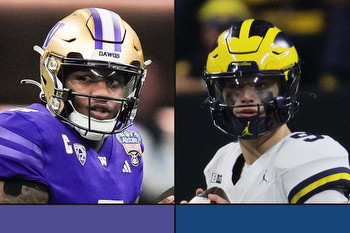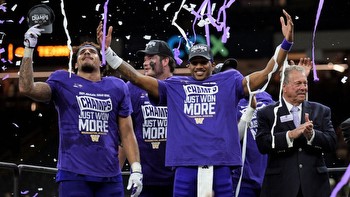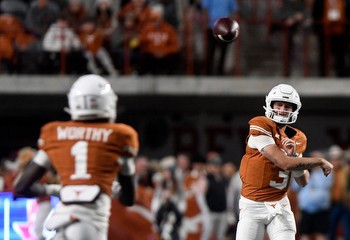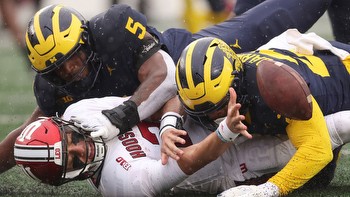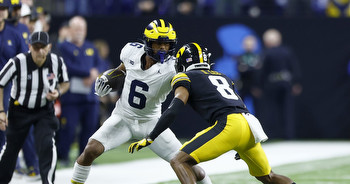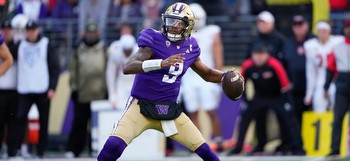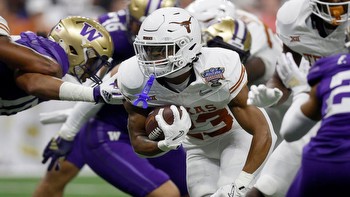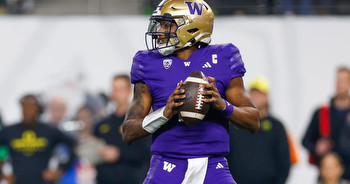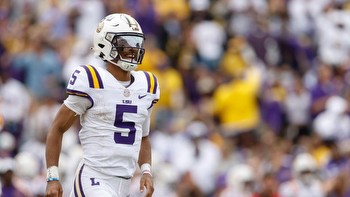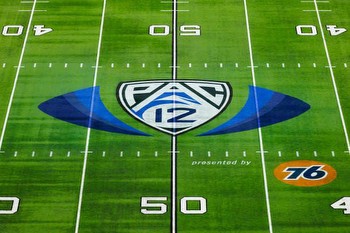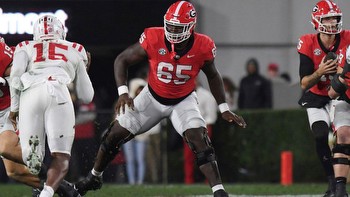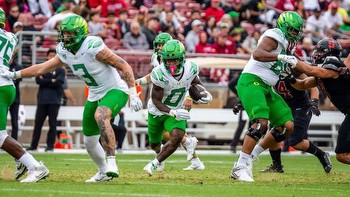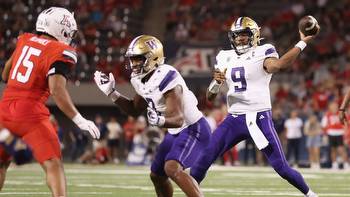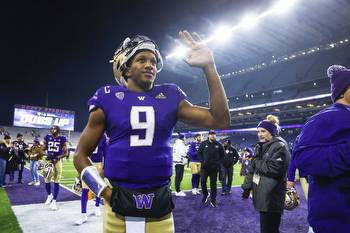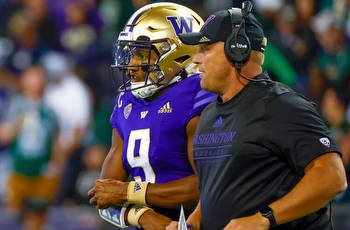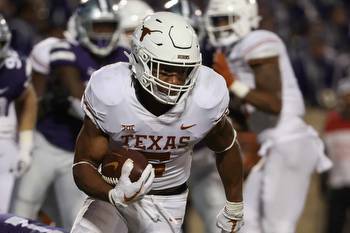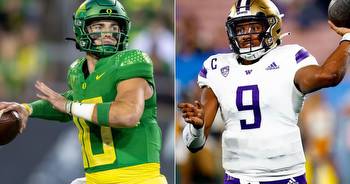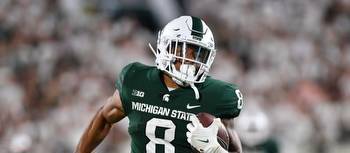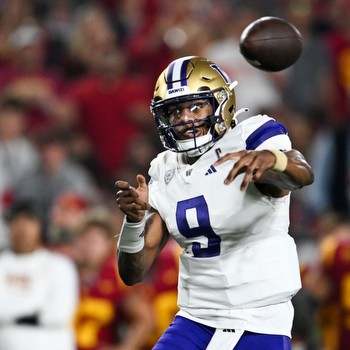2024 Sugar Bowl: Washington vs. Texas advanced stats preview
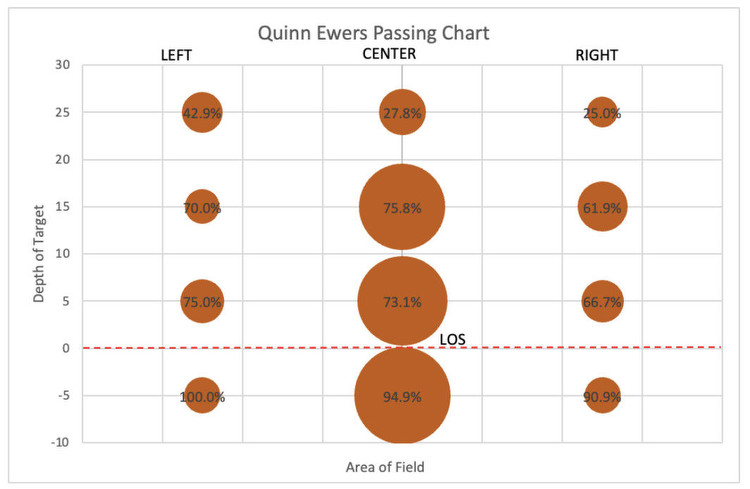
The Texas Longhorns are set to take on the Washington Huskies in the Sugar Bowl next Monday and I am actively seeking out another clip of Bevo scaring the living shit out of a dog again. The game kicks off at 7:45 p.m. Central in New Orleans. Forgive me now, but I could not help myself with this matchup and the sheer joy of a playoff appearance turned into a quite a journey down the rabbit hole of numbers.
The usuals
First focusing on how the Texas offense has developed this season. Quarterback Quinn Ewers took a step up in his game this year, improving his completion rate from 58.1 percent to 70.7 percent on top of increasing his average yards per catch from 7.4 to 9. Texas head coach Steve Sarkisian has utilized the screen pass and running the ball to wait for the opportune moments to let Ewers air it down field. He has accumulated most of his touchdowns through passes over the middle. Below is a visual to understand where Ewers targets the most, with the size of the bubble indicating the number of attempts in that region and the number inside representing his completion percentage.
Texas uses play action in abundance, with 53.6 percent of Ewers’ snaps including the planned fake or read. Ewers has a spectacular 76-percent completion rate, but the number of pressures that turn into sacks is alarmingly high at 30.6 percent. He sometimes has trouble finding a gap out of the pocket in time and is forced to sit down before finding his check-down route. Nevertheless, we have seen Sarkisian really develop this team into a string of first and second round picks that have bought into the culture shift and been built to win. Below are the PPA and box score stats for the rest of the offense this season.
On the opposite side of the ball, the Huskies play in a 4-2-5 scheme they have adopted since the arrival of DC Chuck Morrell. This is a base nickel package with the nickel DB, deemed the “Husky”, being a hybrid linebacker that is good enough in coverage for a slot receiver and not a liability in the run game.
In the pass rush game, edge Braylen Trice (41 total tackles, 5 sacks) is the standout threat, followed by edge Zion Tupuola-Fetui (28, 3.5) who also ranks in the top quartile of players in the PAC-12. In the running game, defensive tackle Tuti Letuligasenoa (16, 0) has been a menace all season long with the rest of the players being above-average contributors. Those include Trice, middle linebacker Edefuan Ulofoshio (83, 3), and safeties Domonique Hampton (92, 0) and Vincent Nunley (16, 0).
Mishael Powell (38, 0) is labeled as the Husky and hasn’t been a sufficient replacement for a strong linebacker at the position, so taking advantage of a size mismatch in his direction will be key. (Granted, he is better at dealing with more agile pass threat of a tight end in Sanders than a strong linebacker would be, but there is a tradeoff, and I don’t think Washington has found THE guy that solves all their problems yet).
In coverage, the linebackers are a big threat for those middle of the field targets. Ulofoshio (2 pass breakups, 1 interception), along with outside linebackers Carson Bruener (3, 1), Alphonzo Tuputala (0, 1), and Ralen Goforth (2, 0) all rank highly, not to mention Powell (6, 3) as well. In the secondary, safeties Nunley (0, 1), Hampton (5, 2), and Kamren Fabiculanan (2, 2) pair well with star cornerback Jabbar Muhammad (10, 3).
Expect Muhammad to take Worthy or Mitchell on every play and Texas will have to find a way to line up JT Sanders, Gunnar Helm, or even Jordan Whittington on the same side as him. Powell is forced to cover the second receiver to the field and forcing him to go up against such big bodies will surely find openings in the short passing options that can help build momentum. Even then, Powell’s escape option will be to pass off his man to the strong safety or will linebacker, so the run game will be important to detract from their helping roles.
The Horns are going up against a Washington team that possesses one of the most high-powered offenses in the country ranking fourth in passing grade and first in receiving amongst power five teams (69 total teams), according to PFF. Rome Odunze was up for debate as one of the nation’s top receivers and will continue to be a dominant outside threat. The Z receiver is then Ja’Lynn Polk, followed by slot receiver Jalen McMillan, who are all deadly with the ball in their hands. Even then, the biggest worry is letting any of them past the safeties as their speed will win every time.
Odunze’s drop in performance when in zone vs. man is worth mentioning. While his yards after catch is better in zone coverage, his routes are held shorter, and he struggles slightly more with contested catches (though he is one of the best in the league still). Similarly, zone also contains Polk’s ability to cruise downfield, but it becomes an easy short game for McMillan and Germie Bernard to find the gaps in the coverage. Below are the offensive stats for the Huskies.
Washington utilizes play action in 30.7 percent of their dropbacks and Michael Penix is deadly efficient. He has a 74.5-percent completion rate, an average depth of target of 11.1 yards, an average throw time of 2.65 seconds, and 12 touchdowns. His numbers aren’t quite exceptional without play action with a 62.1-percent completion rate, average depth of target of 11 yards, throw time of 2.71 seconds, with 21 touchdowns and all nine of his interceptions on the season. I think this speaks to running back Dillon Johnson’s ability to stretch opposing defenses thin, force teams to load the box in anticipation of the run, and allow deeper routes to develop.
The deep zone (plus 20 yards) is the most volatile area of Penix’s play, where he has tallied 14 of his touchdowns, but also seven of his interceptions. When kept with a clean pocket he can be dangerous as his average throw time for the deep middle of the field is 3.26 seconds, for an average depth of target of 33.4 yards, and an impressive 15-of-28 passes completed. The Longhorn secondary will have their work cut out for them if left on an island against any of the talented Husky receivers. Penix’s favorite spot is over the middle in the 0-10 yard range, completing 73-of-89 passes for four touchdowns. Below is a more detailed explanation of his passing targets.
Penix doesn’t perform as well under pressure, but the numbers aren’t as big of a drop off considering his experience and composure. He has been pressured on nearly a quarter of his dropbacks, throwing the ball away 20 times and taking just 11 sacks.
Big-picture trends
The first team-wide lens to view how these teams move the ball is Eckel rate. We already discussed red-zone success this season, but Eckel rate allows us to examine how teams perform outside of the red zone. Eckel is defined as a possession that results in a big-play touchdown from outside the opponent’s 40-yard line or gaining a first down inside the 40, thus Eckel rate is the percentage of possessions this occurs in. We can then compare that to red-zone efficiency through traditional metrics like touchdowns or field goals from inside the red zone, but here I am using points per Eckel. Teams that are great at moving the ball downfield, as well as scoring from inside the red zone should float towards the top right. I have also included two other points showing the Eckels allowed by each team’s defense.
Despite some rough quarters, there hasn’t been much doubt about the Longhorns being able to get the ball past midfield. The struggle then occurs from the extremely low red-zone efficiency which translates to just 3.14 points per Eckel. Fortunately, Washington’s defense isn’t exactly a staunch terror at holding opposing teams to low Eckel rates as they allow 40 percent of possessions to get downfield. You could simply look at this just by distance and observe that Washington’s defense will be more lenient given the Texas offense.
On the flip side, their offense has been elite, as mentioned before. Being able to move down the field and score as well, averaging 4.42 points per Eckel. But the Longhorns hold their ground, allowing just 31 percent Eckel rate and 2.82 points per Eckel. The extremes that both teams bring the table will be extraordinary to see develop throughout the game.
Washington possesses a run game that often gets overlooked considering the pizazz that Penix Jr and Odunze bring. Although they rank 22nd running amongst Power Five teams, they do rank 15th in run blocking and Dillon Johnson was crucial down the stretch in the Pac-12 Championship game.
The chart below shows the success rate above expected against all of Washington’s opponents. As a reminder, a successful play is one that results in one of the following:
- 50 percent or more needed yards gained on first down
- 70 percent or more needed yards gained on second down
- A third or fourth down conversion
- A touchdown
I attempted to simplify this with any positive bar, meaning Washington was a tougher game in that category than other teams that opponent faced throughout the season. For instance, Tulsa was not ready for the Huskies’ passing offense, but they were barely phased by the Huskies’ passing defense. Bars trending downwards meaning that on that given Saturday, Washington was an easier team to play in that category.
Other pros for the Huskies are that they are 20th in pass rushing, 11th in pass coverage and 4th in special teams. Where they fall closer to average is run stopping, ranking 32nd and they are staggeringly low at 62nd in tackling.
Their rushing offense shines through again as they only seemed to disappear in their games against Stanford and Oregon state. Their passing game has the ability to blow teams out of the water like against Tulsa or California, but they also fail to show up occasionally. We can see this in games against a very weak Michigan State, plus major struggles against Arizona State, Stanford, Oregon State, and Washington State.
On the other side of the ball is a very similar story. They have demonstrated their ability to be a dominant run stopping defense in certain games, but they are worse than most teams their opponents face in half of their schedule. Meanwhile, their passing coverage doesn’t put up the same attention-grabbing numbers but more consistently performs as they should.
The same success rate above expected chart is shown for all the Longhorns’ games.
The pros for Texas are they are 23rd in passing, third in pass blocking, 10th in receiving, 19th in running, seventh in run defense, ninth in pass rushing, and third in special teams. The cons are they are 31st in run blocking, 50th in tackling, and 32nd in pass coverage.
The heart of this Texas team has long been establishing the run and that has been a continuous force throughout each game (except BYU). The passing game has shown to be electrifying, and trust me, there is a noise complaint whenever I witness a beautiful rainbow pass to Worthy or Mitchell. But I am still stuck on the underwhelming performances against Wyoming and Houston where one hot quarter isn’t enough to make me happy given how close these games were for the other three quarters.
The rushing defense again proves to be an immovable object going forward and I am confident that the Horns will continue to rely on them again to be the difference maker. The biggest concern now comes down pass coverage. Texas was frustrating to watch for a stretch of games which we can blame on injured players, and conservative/cushioned play calling and this is demonstrated in the data. I believe allowing cornerbacks like Ryan Watts to play aggressive one-on-one can have a big payoff, and it will be a tough decision to assign him Odunze and trust him to deliver.
Both teams have excellent offensive lines with Texas ranking third and Washington fourth in the nation. However, I believe the X-factor as expected will be the impact of each team’s defensive lines. I constructed a scatter plot showing how they performed against their opponents with a similar methodology but focusing on the line yards gained this time. An interpretation here is that both sides of the Texas team had great performance against Kansas State, with the offense gaining 0.7 yards more than the Wildcats usually allow, and the defense allowing 0.9 yards less than the Wildcats usually gain.
The distribution of performances for Washington’s offensive line is very similar to Texas with the exception of their first game against Oregon in which they struggled significantly (they generated 1.9 yards less than the Oregon defense typically allows). But I think we should focus on the adjustment made as they came back appearing like one of the toughest lines Oregon had seen all year in their conference championship game. The hope is that they aren’t prepared for the deadly combo of T’Vondre Sweat and Byron Murphy, but they clearly fixed a gaping problem in their run blocking. For Texas, the offensive line was on the ropes against BYU, but has held their ground for the most part. And the data point against Alabama needs to be taken with a grain of salt as the Crimson Tide was able to drastically elevate their line yard numbers as the season progressed.
There is a proudly distinct difference in the performance of the Texas defensive front. There was not a single game in which they performed worse than expected and their dominance showed up in the games against Houston, Baylor, Kansas, and Oklahoma State. Meanwhile, Washington’s defensive front rose to the occasion against Oregon, Oregon State, and Cal, but gave way to every other opponent they faced, with USC being their worst game. Thus, I still think it is fair enough to say that the Texas defense will be a more imposing threat to the Huskies O-line versus the Washington defense against the Texas O-line.
As the numbers guy, I am severely struggling to not let emotions interfere with my prediction for this game. I firmly believe that Sarkisian can get points on the board, especially if he had 30-plus against Alabama and Oklahoma. The offense needs to get rolling and stay rolling to allow the defense ample recovery time. Texas has shut down great running teams before, but the difference was that they had average passing attacks, and our defense was good enough to get by on that. Washington is an entirely different animal, and the weight on our secondary’s shoulders is heavy. If they show up, I will see y’all in Houston.

